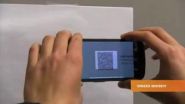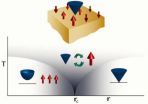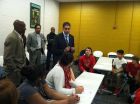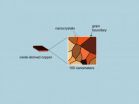(Press-News.org) VIDEO:
Professor Kevin Du and his team at Syracuse University have identified apps that could cause problems for smartphone users, allowing hackers easy access to sensitive information.
Click here for more information.
Professor Kevin Du and a team of researchers from the College of Engineering and Computer Science at Syracuse University have recently discovered that some of the most common activities among smartphone users—scanning 2D barcodes, finding free Wi-Fi access points, sending SMS messages, listening to MP3 music and watching MP4 videos—can leave devices vulnerable to harmful "computer worms."
These worms can infiltrate smartphones through apps designed in a specific computer language/code—and they can do more harm than just steal the device owner's personal information, researchers warn. They can also spread to the owner's friends and personal contacts.
"These attacks target an increasingly popular type of app known as HTML5-based app," says Du who worked on the research with students Xing Jin, Tongbo Luo and Derek G. Tsui. "Traditionally, apps are developed using a platform's native technologies, such as Java in Android and Object C in iOS. HTML5-based apps do not use platform-dependent native technologies, but use JavaScript instead, which is universally supported by all platforms.
"The advantage for developers is clear: write an app once and it can run on all major platforms," Du explains.
The team has so far identified 14 vulnerable HTML5-based apps from three types of mobile systems, including Android, iOS and Blackberry. Developers of those vulnerable apps have been informed and in an effort to give them time to fix the problem, researchers have decided not to disclose the names of the vulnerable apps.
"Imagine you're at the airport and you want to find the free Wi-Fi. When you scan, your phone is going to display the Wi-Fi access points. That could be an easy channel for a hacker to inject malicious worm code into your smartphone," Du says. "Once the worm takes control, it can duplicate itself, and send copies to your friends via SMS messages, multimedia file sharing, and other methods."
Researchers are currently working to develop solutions to help users and app developers detect and prevent such attacks.
Details of how attacks can occur this attack are described in a paper titled "XDS: Cross-Device Scripting Attacks on Smartphones through HTML5-based Apps" that the team will present at the Mobile Security Technologies workshop in May.
Du and his team are continuing their research to see what other apps might be at risk.
"We are launching a large scale search in the Google Play market and expect to find more vulnerable apps," says Du. "By 2016, it's estimated that more than fifty percent of the mobile apps will be produced using HTML-5 technology. This is just a disaster waiting to happen," he adds.
INFORMATION:
Researchers discover dangerous ways computer worms are spreading among smartphones
Professor Kevin Du and his team have found that simple smartphone activities, including sending text messages, can leave devices vulnerable to computer worms
2014-04-09
ELSE PRESS RELEASES FROM THIS DATE:
Stanford scientists model a win-win situation: Growing crops on photovoltaic farms
2014-04-09
Growing agave and other carefully chosen plants amid photovoltaic panels could allow solar farms not only to collect sunlight for electricity but also to produce crops for biofuels, according to new computer models by Stanford scientists.
This co-location approach could prove especially useful in sunny, arid regions such as the southwestern United States where water is scarce, said Sujith Ravi, who is conducting postdoctoral research with professors David Lobell and Chris Field, both on faculty in environmental Earth system science and senior fellows at the Stanford Woods ...
Medication therapy management works for some but not all home health patients
2014-04-09
WEST LAFAYETTE, Ind. — Low-risk Medicare patients entering home health care who received medication therapy management by phone were three times less likely to be hospitalized within the next two months, while those at greater risk saw no benefit, according to a study led by Purdue University.
The study helped determine which patients benefit most from medication therapy management by phone and a way to identify them through a standardized risk score, said Alan Zillich, associate professor of pharmacy practice at Purdue, who led the research.
"Hopefully, this study ...
UC-led research finds chips with olestra cause body toxins to dip
2014-04-09
According to a clinical trial led by University of Cincinnati researchers, a snack food ingredient called olestra has been found to speed up the removal of toxins in the body.
Results are reported in the April edition of the Journal of Nutritional Biochemistry.
The trial demonstrated that olestra—a zero-calorie fat substitute found in low-calorie snack foods such as Pringles—could reduce the levels of serum polychlorinated biphenyls (PCBs) in people who had been exposed to PCBs.
High levels of PCBs in the body are associated with an increase in hypertension and diabetes. ...
Gusev Crater once held a lake after all, says ASU Mars scientist
2014-04-09
TEMPE, Ariz. - If desert mirages occur on Mars, "Lake Gusev" belongs among them. This come-and-go body of ancient water has come and gone more than once, at least in the eyes of Mars scientists.
Now, however, it's finally shifting into sharper focus, thanks to a new analysis of old data by a team led by Steve Ruff, associate research professor at Arizona State University's Mars Space Flight Facility in the School of Earth and Space Exploration. The team's report was just published in the April 2014 issue of the journal Geology.
The story begins in early 2004, when NASA ...
One kind of supersymmetry shown to emerge naturally
2014-04-09
UC Santa Barbara physicist Tarun Grover has provided definitive mathematical evidence for supersymmetry in a condensed matter system. Sought after in the realm of subatomic particles by physicists for several decades, supersymmetry describes a unique relationship between particles.
"As yet, no one has found supersymmetry in our universe, including at the Large Hadron Collider (LHC)," said the associate specialist at UCSB's Kavli Institute for Theoretical Physics (KITP). He is referring to the underground laboratory in Switzerland where the famous Higgs boson was identified ...
Violence intervention program effective in Vanderbilt pilot study
2014-04-09
Violent behavior and beliefs among middle school students can be reduced through the implementation of a targeted violence intervention program, according to a Vanderbilt study released in the Journal of Injury and Violence Research.
Manny Sethi, M.D., assistant professor of Orthopaedic Surgery and Rehabilitation, and his Vanderbilt co-authors evaluated 27 programs nationwide as part of a search for an appropriate school-based violence prevention program.
Their findings led to a single, evidence-based conflict resolution program that was evaluated in a pilot study of ...
Stanford scientists discover a novel way to make ethanol without corn or other plants
2014-04-09
Stanford University scientists have found a new, highly efficient way to produce liquid ethanol from carbon monoxide gas. This promising discovery could provide an eco-friendly alternative to conventional ethanol production from corn and other crops, say the scientists. Their results are published in the April 9 advanced online edition of the journal Nature.
"We have discovered the first metal catalyst that can produce appreciable amounts of ethanol from carbon monoxide at room temperature and pressure – a notoriously difficult electrochemical reaction," said Matthew ...
Novel approach to accelerate metabolism could lead to new obesity treatment
2014-04-09
BOSTON – By manipulating a biochemical process that underlies cells' energy-burning abilities, investigators at Beth Israel Deaconess Medical Center (BIDMC) have made a novel discovery that could lead to a new therapy to combat obesity and diabetes.
Published in the April 10 issue of the journal Nature, the new findings show that reducing the amount of nicotinamide N-methyltransferase (NNMT) protein in fat and liver dramatically reduces the development of obesity and diabetes in mice.
'With this discovery, we now have a means of metabolic manipulation that could ...
A bad penny: Cancer's thirst for copper can be targeted
2014-04-09
DURHAM, N.C. – Drugs used to block copper absorption for a rare genetic condition may find an additional use as a treatment for certain types of cancer, researchers at Duke Medicine report.
The researchers found that cancers with a mutation in the BRAF gene require copper to promote tumor growth. These tumors include melanoma, the most dangerous form of skin cancer that kills an estimated 10,000 people in the United States a year, according to the National Cancer Institute.
"BRAF-positive cancers like melanoma almost hunger for copper," said Christopher M. Counter, ...
UC San Diego researchers develop bacterial 'FM radio'
2014-04-09
Programming living cells offers the prospect of harnessing sophisticated biological machinery for transformative applications in energy, agriculture, water remediation and medicine. Inspired by engineering, researchers in the emerging field of synthetic biology have designed a tool box of small genetic components that act as intracellular switches, logic gates, counters and oscillators.
But scientists have found it difficult to wire the components together to form larger circuits that can function as "genetic programs." One of the biggest obstacles? Dealing with a small ...
LAST 30 PRESS RELEASES:
Tracing the quick synthesis of an industrially important catalyst
New software sheds light on cancer’s hidden genetic networks
UT Health San Antonio awarded $3 million in CPRIT grants to bolster cancer research and prevention efforts in South Texas
Third symposium spotlights global challenge of new contaminants in China’s fight against pollution
From straw to soil harmony: International team reveals how biochar supercharges carbon-smart farming
Myeloma: How AI is redrawing the map of cancer care
Manhattan E. Charurat, Ph.D., MHS invested as the Homer and Martha Gudelsky Distinguished Professor in Medicine at the University of Maryland School of Medicine
Insilico Medicine’s Pharma.AI Q4 Winter Launch Recap: Revolutionizing drug discovery with cutting-edge AI innovations, accelerating the path to pharmaceutical superintelligence
Nanoplastics have diet-dependent impacts on digestive system health
Brain neuron death occurs throughout life and increases with age, a natural human protein drug may halt neuron death in Alzheimer’s disease
SPIE and CLP announce the recipients of the 2025 Advanced Photonics Young Innovator Award
Lessons from the Caldor Fire’s Christmas Valley ‘Miracle’
Ant societies rose by trading individual protection for collective power
Research reveals how ancient viral DNA shapes early embryonic development
A molecular gatekeeper that controls protein synthesis
New ‘cloaking device’ concept to shield sensitive tech from magnetic fields
Researchers show impact of mountain building and climate change on alpine biodiversity
Study models the transition from Neanderthals to modern humans in Europe
University of Phoenix College of Doctoral Studies releases white paper on AI-driven skilling to reduce burnout and restore worker autonomy
AIs fail at the game of visual “telephone”
The levers for a sustainable food system
Potential changes in US homelessness by ending federal support for housing first programs
Vulnerability of large language models to prompt injection when providing medical advice
Researchers develop new system for high-energy-density, long-life, multi-electron transfer bromine-based flow batteries
Ending federal support for housing first programs could increase U.S. homelessness by 5% in one year, new JAMA study finds
New research uncovers molecular ‘safety switch’ shielding cancers from immune attack
Bacteria resisting viral infection can still sink carbon to ocean floor
Younger biological age may increase depression risk in older women during COVID-19
Bharat Innovates 2026 National Basecamp Showcases India’s Most Promising Deep-Tech Ventures
Here’s what determines whether your income level rises or falls
[Press-News.org] Researchers discover dangerous ways computer worms are spreading among smartphonesProfessor Kevin Du and his team have found that simple smartphone activities, including sending text messages, can leave devices vulnerable to computer worms






